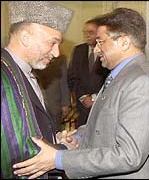|
New
Afghanistan Map Includes Big Pakistani Cities
|
|
By Syed Saleem Shahzad |
 |
KARACHI:
The Afghans ruling Kabul are now asking the US
to renegotiate the border between Pakistan and
Afghanistan and some Afghan officials have already
issued a new map that shows major Pakistani cities
of Peshawar and Quetta as part of Afghanistan.
|
These
Afghan leaders say the demarcation of border between the
two countries in 1893 was for 100 years only and that
agreement which drew the controversial Durand Line, expired
in 1993. Thus a new border has to be negotiated.
Faced with the uphill task of curtailing
extremist elements in South and Central Asia, such as
al-Qaeda and the Taliban, the United States appears
to be leaning towards a policy of promoting instability
in the region, with the biggest loser in such a game
likely to be Pakistan, even though it is Washington's
stated premier ally in the "war on terror".
Reports emerging from Pakistan's North-West
Frontier Province (NWFP)and Balochistan suggest a revival
of Pashtun nationalist activity over the sensitive issue
of the Durand Line, which demarcates the border between
Pakistan and Afghanistan, at a time when military operations
continue in the Pakistani tribal belt, much to the annoyance
of the local tribals towards the Pakistan army and the
establishment.
A coalition of six fundamentalist, pro-Taliban
and pro-Osama bin Laden parties under the umbrella of
the Muttahida Majlis-e-Amal (MMA) came to power in NWFP
in last October's general elections, and the MMA is
a part of the ruling coalition in Balochistan.
Many in the present Afghan government
believe that the agreement reached between Afghan king
Abdur Rahman Khan and British colonial official Sir
Henry Mortimer Durand in 1893 that defined the Durand
Line was for 100 years only, and expired in 1993. The
Afghans are now asking the US to renegotiate the border,
and some Afghan officials have already issued a new
map that shows such major Pakistani cities as Peshawar
and Quetta in Afghanistan.
Asia Times Online sources close to Pakistan
strategic circles report that there has been recent
contact between Afghan leader Hamid Karzai and Pashtun
leader Khan Abdul Wali Khan, much to the alarm of the
Pakistani hierarchy, which is convinced that the meeting
took place at the instigation of the US.
Khan's Awami National Party, which is
traditionally anti-establishment, was wiped out in the
last elections. His father, Khan Abdul Ghaffar Khan,
opposed the partition of British India in 1947, and
because of his close association with Mahatma Gandhi
he was called Sarhadi Gandhi (NWFP is called Sarhad
in Urdu and Hindi). Like his father, Wali Khan has close
ties with India and Afghanistan. After the former USSR
invaded Afghanistan in the 1980s, Wali Khan coined the
concept of "Pashtunistan" and called for a
"red revolution" in Pakistan to welcome Soviet
forces to help in the unification of Pashtun lands on
both sides of the Durand Line.
The meeting between Wali Khan and Hamid
took place against the backdrop of an organized campaign
in the shape of seminars and public gatherings in NWFP
and Balochistan designed ignite debate over the issue
of "Pashtunistan", and with clear US patronage.
Afghan delegations from Europe and America have visited
Peshawar and Quetta, where they spoke openly of the
Durand Line issue, and urged Pashtuns to unite and claim
their rights.
They said that the Durand Line had not
only affected the history of Pashtuns, but had also
changed their social and economic conditions. Germany-based
Afghan Makhan Shinwari said that the Durand Line was
the result of a conspiracy aimed at breaking Pashtun
power. Such talk has not been heard in the volatile
region for many years.
The Soviets last played this card during
their occupation of Afghanistan in the 1980s in an attempt
to destabilize the country. But after the collapse of
the USSR and the communist government in Afghanistan,
nationalist factions dropped the issue and joined hands
with right wing parties like the Pakistan Muslim League
(Nawaz) for the first time in the history of Pakistan,
if only to show that the demand for a Pashtun land had
never been indigenous, but always instigated by foreigners.
But now, with the Pakistani military
intervention in the tribal belt, and the complete silence
of the MMA, nationalist elements are furthering their
move for a greater Pashtun territory from Kabul to Peshawar
and Quetta.
This development has broader implications.
An immediate one could be a revival in the movement
for a greater Balochistan. Ethnically, Baloch areas
exist in Afghanistan, Iran and Pakistan. Pakistani Balochistan
is known as the "Third International" as it
is the most important segment of the Baloch regions
and could play an important role as a catalyst for revolution
in Afghanistan and Iran.
For this reason, the former USSR invested
a lot of resources in making Balochistan a breeding
point of nationalism and socialism. These anti-establishment
trends were then exported to Iranian Balochistan.
Inflammatory issues such as Pashtunistan
and "Greater Balochistan" have the potential
to slice the existing power bases in Afghanistan, Pakistan
and Iran. Iranian Balochis, for example, are culturally
and religiously (being Sunnis) as well as politically
(liberal) totally different from the majority of Shi'ite
Iran.
A Pashtun nationalist revival could
also stir a counter revival movement in northern Afghanistan
in the ethnically Tajik and Uzbek areas, leading to
the country's Balkanization.
And further afield, who knows what other
indigenous movements could be awoken - from a "Greater"
Kashmir - which is already simmering - to a "Greater"
Punjab.
This is long term though. The immediate
result of raising the Pashtunistan issue is instability
in Pakistan, Iran and Afghanistan, which is already
in deep turmoil, and help for the US in enhancing its
influence in the region.
|
